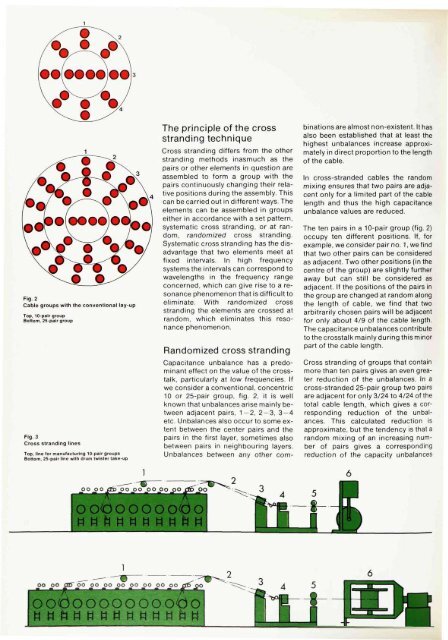Selection and Testing of Electronic Components for LM
Selection and Testing of Electronic Components for LM
Selection and Testing of Electronic Components for LM
You also want an ePaper? Increase the reach of your titles
YUMPU automatically turns print PDFs into web optimized ePapers that Google loves.
Fig. 2<br />
Cable groups with the conventional lay-up<br />
Top, 10-palr group<br />
Bottom, 25-palr group<br />
Fig. 3<br />
Cross str<strong>and</strong>ing lines<br />
Top, line lor manufacturing 10-palr groups<br />
Bottom, 25-pair line with drum twister take-up<br />
The principle <strong>of</strong> the cross<br />
str<strong>and</strong>ing technique<br />
Cross str<strong>and</strong>ing differs from the other<br />
str<strong>and</strong>ing methods inasmuch as the<br />
pairs or other elements in question are<br />
assembled to <strong>for</strong>m a group with the<br />
pairs continuously changing their relative<br />
positions during the assembly. This<br />
can be carried out in different ways. The<br />
elements can be assembled in groups<br />
either in accordance with a set pattern,<br />
systematic cross str<strong>and</strong>ing, or at r<strong>and</strong>om,<br />
r<strong>and</strong>omized cross str<strong>and</strong>ing.<br />
Systematic cross str<strong>and</strong>ing has the disadvantage<br />
that two elements meet at<br />
fixed intervals. In high frequency<br />
systems the intervals can correspond to<br />
wavelengths in the frequency range<br />
concerned, which can give rise to a resonance<br />
phenomenon that is difficult to<br />
eliminate. With r<strong>and</strong>omized cross<br />
str<strong>and</strong>ing the elements are crossed at<br />
r<strong>and</strong>om, which eliminates this resonance<br />
phenomenon.<br />
R<strong>and</strong>omized cross str<strong>and</strong>ing<br />
Capacitance unbalance has a predominant<br />
effect on the value <strong>of</strong> the crosstalk,<br />
particularly at low frequencies. If<br />
we consider a conventional, concentric<br />
10 or 25-pair group, fig. 2, it is well<br />
known that unbalances arise mainly between<br />
adjacent pairs, 1—2, 2 — 3, 3 — 4<br />
etc. Unbalances also occur to some extent<br />
between the center pairs <strong>and</strong> the<br />
pairs in the first layer, sometimes also<br />
between pairs in neighbouring layers.<br />
Unbalances between any other com<br />
binations are almost non-existent. It has<br />
also been established that at least the<br />
highest unbalances increase approximately<br />
in direct proportion to the length<br />
<strong>of</strong> the cable.<br />
In cross-str<strong>and</strong>ed cables the r<strong>and</strong>om<br />
mixing ensures that two pairs are adjacent<br />
only <strong>for</strong> a limited part <strong>of</strong> the cable<br />
length <strong>and</strong> thus the high capacitance<br />
unbalance values are reduced.<br />
The ten pairs in a 10-pair group (fig. 2)<br />
occupy ten different positions. If, <strong>for</strong><br />
example, we consider pair no. 1, wefind<br />
that two other pairs can be considered<br />
as adjacent. Two other positions (in the<br />
centre <strong>of</strong> the group) are slightly further<br />
away but can still be considered as<br />
adjacent. If the positions <strong>of</strong> the pairs in<br />
the group are changed at r<strong>and</strong>om along<br />
the length <strong>of</strong> cable, we find that two<br />
arbitrarily chosen pairs will be adjacent<br />
<strong>for</strong> only about 4/9 <strong>of</strong> the cable length.<br />
The capacitance unbalances contribute<br />
to the crosstalk mainly during this minor<br />
part <strong>of</strong> the cable length.<br />
Cross str<strong>and</strong>ing <strong>of</strong> groups that contain<br />
more than ten pairs gives an even greater<br />
reduction <strong>of</strong> the unbalances. In a<br />
cross-str<strong>and</strong>ed 25-pair group two pairs<br />
are adjacent <strong>for</strong> only 3/24 to 4/24 <strong>of</strong> the<br />
total cable length, which gives a corresponding<br />
reduction <strong>of</strong> the unbalances.<br />
This calculated reduction is<br />
approximate, but the tendency is that a<br />
r<strong>and</strong>om mixing <strong>of</strong> an increasing number<br />
<strong>of</strong> pairs gives a corresponding<br />
reduction <strong>of</strong> the capacity unbalances
















